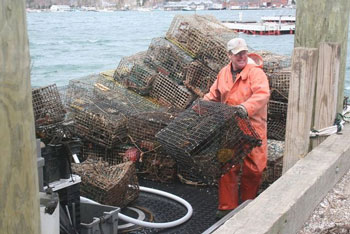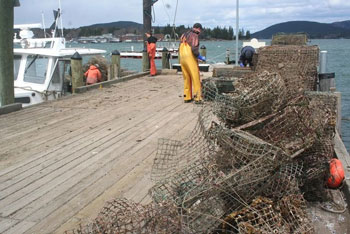Ghost Gear Cleanup Continues
for Second Year
by Laurie Schreiber

Islesford fisherman Bruce Fernald gets ready to toss derelict traps onto the Manset town dock for disposal. Laurie Schreiber Photo
The two-year Lobster Gear Retrieval, Salvage and Disposal Project completed its second season recently, when fishermen in Zones D-G and in the Mount Desert Island area retrieved hundreds of traps lost on the ocean bottom. The tally of the traps numbers was not completed by press time.
The project was designed by the Gulf of Maine Lobster Foundation and the Department of Marine Resources (DMR), and was primarily funded through a $200,000 award from the National Fish and Wildlife Foundation’s 2009 Gulf of Maine Environmental Compliance and Protection Fund.
The funds stemmed from community service payments ordered as part of a criminal penalty imposed upon a shipping company for criminal violations related to deliberate vessel pollution in close proximity to the state of Maine.
During the first year of the project, from February through April 2010, more than 1,100 derelict lobster traps were recovered in six days from the state’s easternmost lobster zones, Zone A, B and C.
This year, the federal funds for the project went to the four western lobster fishing zones, Zones D-G. The project took place in the Casco Bay region April 7-8; and the Kennebec-Sheepscot-Boothbay and the Owls Head-Spruce Head-Muscongus Bay area the week of April 11. Mount Desert Island and the nearby offshore islands are part of Zone B, and were therefore included as part of the 2010 cleanup.
But the project was able to return to the MDI area when additional funding was donated by the New York Yacht Club, the Northeast Harbor Fleet, Blue Hill’s Kollegewidgwok Yacht Club, and the Eastern Yacht Club in Marblehead, Mass., whose regattas often pass through dense lobster buoys fields, said Ludwig.

Busted ghost traps are loaded onto a pickup truck for their last journey to a recycling facility. Some traps are found clustered in large balls, wound together by tides and currents. Laurie Schreiber Photo
“That’s the whole premise of coming back here—to recover traps that are lost during sailing regattas,” said foundation project director Laura Ludwig. “This was the yacht clubs’ initiative. They acknowledge that they decimate the buoy fields, and they realize they’re generating these lost traps. The sailboats recognize that, when they hook into buoys, they either move traps or they cut them right off.”
Ludwig said the contribution of the yacht clubs makes for a great partnership.
“I’m hoping the sailboat fleet take some pride in that because, in my opinion, it’s unprecedented,” she said.
Overall, she said, the project works with the fishing industry to recover, document and properly dispose of derelict fishing gear. The gear is either recycled or returned to its owner, depending on its condition.
For the MDI cleanup, Bruce Fernald and Richard Howland from Islesford; Joe Chalmers from Southwest Harbor; Brennan Spofford from Bass Harbor; and Jason Joyce, Josh Joyce and Chris Sawyer from Swans Island put up with some wet and windy weather for much of the effort to retrieve lost lobster traps from the ocean bottom.
The traps were lost when their buoy lines parted at the ocean’s surface. It is unknown how many of these “ghost traps,” as they are called, litter the ocean bottom, said Ludwig. The number one cause of lost traps is boat traffic that cuts off the trap’s buoys at the surface, she said.
“That could be sailboats, recreational boats or even other fishing vessels, according to the fishermen,” Ludwig said. The work in Blue Hill Bay wrapped up this year’s project. “We’ve been going great guns.”
Although the tally isn’t in yet, she said that unofficially, “the total number of traps recovered is in the vicinity of over a thousand. I don’t know how many are good and how many aren’t. They’re sorted when they come on shore, and tossed when they’re junk—scrapped for metal scrap. If they’re reasonable, even barely fishable, we ID them based on the trap tag in the trap, and contact the owner. We give them a week or two to pick up their traps.”
Eventually, she said, the foundation would like to conduct a comprehensive survey in order to determine just how much derelict gear is out there, and retrieve it.
For now, though, she said, “this is the guys knowing where the trash is and going to get it.”
